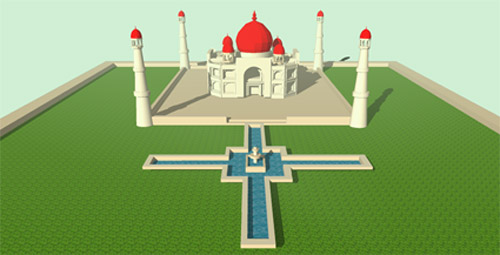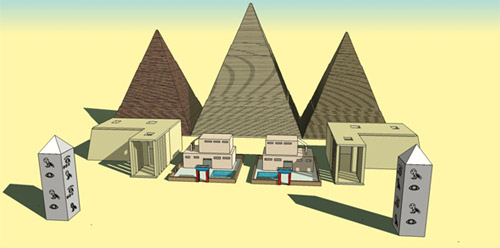Teaching with Sketchup: using 3D to spark creativity in children
Artur Coelho
AE Venda do Pinheiro, Portugal
F575@aevp.net
Sktechup, as we all know so well, is a very powerful 3d modeling tool with a range of applications from professional architecture and engineering to hobbyists. But can we go further? Can we use Sketchup as a teaching tool, sparking creativity in young children, exposing them to advanced tools and higher lever workflows, teaching them to overcome their limits with advanced tools, instilling them with useful knowledge in STEM areas, and also mixing arts with technology? Essentially, broadening horizons and teaching them to take ownership of digital technologies, beyond the corporate view of the user as mere consumer of digital trinkets?
Our personal answer is yes. Since 2009, we’ve been working in Portugal with successive generations of students using 3D technologies to learn ICT in a trandisciplinary setting, mixing arts, science, history and languages with project based learning. We began with the 3DAlpha project, using 3D modeling, animation and virtual worlds with pupils aged 6 to 15 years old. Looking ahead to the intriguing possibilities of 3D printing, we recently began the TIC em 3D project (ICT in 3D) to actively investigate pedagogical uses of 3d technologies, 3D printing, open hardware and STEM education.

A primary school classroom with students busy creating simple animations
Within these projects we use a lot of 3D modeling and animation applications. Since the age of the pupils is very young, we do not focus in a single high-end 3d modeling app that could do all the things we do with the ones we use. One of the aims is to work at introductory levels, wich means that complex software, difficult to master, is not appropriate for our goals. We use an old modeling app, DogaL3, Bryce to render and animate, Vivaty Studio for VRML/X3D design, and, crucially, Sketchup. We began using classical Google Sketchup, and have accompanied the evolution into Sketchup Make.

One of the finest projects created by our pupils, mixing arts/history with 3D modeling
Classroom workflow is structured in two great moments: learning how to use the tools, and creating personal projects. Tool use is a necessary first step, but we believe in empowering students with digital tools as a means for creative expression, to contradict the user/consumer paradigm that underlies the modern digital world and giving them what, due to time constraints, a glimpse that they can do much more with digital tools than game, produce documents and consume media. Therefore, the second moment is about personal creativity, with freedom to create whatever projects the students imagine.

Learning Sketchup tricks in the classroom, and quickly going beyond what was taught
It’s almost unbelievable the way our young students use Sketchup Make. It’s intuitive modeling tools make the creation process very easy. Apart from gaming environment such as Minecraft, they have no previous 3D modeling experience, but generally they require only two introductory lessons to start using Sketchup. The ease of use of this tool makes it easy to use with very young students. In some of the projects created in the ICT In 3D umbrella theme Sketchup was used by six to ten and eleven year old pupils. Of course, the end results get better with older students, but this shows just how Sketchup makes the 3D creation process so easy, kids can literally do it.

Another project, showcasing links between different curricula and a modular, computational-thinking approach to problem solving
After learning about Sketchup, what do our students create? Not surprisingly, architectural modeling is a favourite among them. The models are simple, from an architect’s point of view, but remember that this is only a general introduction, not a full-fledged vocational course. Some of our students like the creative freedom that Sketchup allows, and lose themselves creating very detailed constructions. The outside of the models look deceptively simple, mere cubes with pointy roofs, but when we step inside we marvel at all the small details that the students painstakingly model. Coordinating a classroom in these moments is challenging and fun. And also very heartwarming, seeing the students solve problems and creating very cool models, always smiling from ear to ear.

A simple house, whose walls are hiding painstakingly detailed interiors, all carefully modeled by the students
Other students prefer more guided projects. To those we generally propose modeling in 3D a landmark building, wich they have ti recreate using their nascent skills. These sort of projects involve a lot of thinking, researching, visualization and conceptualization, breaking a larger problem into smaller, simpler tasks, and a lot a flexibility in computer use.
Due to time constraints, pupil’s age range, and the need to introduce other ICT concepts (such as programming or digital safety), we concentrate only on the elementary modeling tools: tracing, push-pull extrusion, moving, scaling and texturing. They are generally enough for our students needs. As we have written earlier, this is an introductory course for the general public, not a deep learning experience. Lately we’ve been introducing them to the follow me tool, with very interesting results. In an academic setting Sketchup is also a cool tool to underlie transdisciplinary knowledge. Widely seen as the boogeyman at school, mathematics and geometry are very interesting to talk about using Sketchup. Abstract notions such as coordinate systems are plainly in view. Geometry, from point to volume, becomes a routine tool. Geometric concepts such as median, tracing figures, diagonals, space, surface generating with axis revolution are not the difficult to understand but simple ways of creating. The arts curricula is also In the spotlight. Using Sketchup forces the students to think in terms of space, and shape, to understand colour and textures, and to use geometric representation systems. To other curricula Sketchup (and general 3D) becomes a powerful information processing tool, with which students can work with concepts from history, social sciences, languages and other areas using multimedia.
Using sketchup has enabled us to explore ICT more creatively. We also hope to foster interest in architecture and engineering, enabling young children to discover areas of interest and personal talents at an early age. This is possible thanks to Sketchup’s ease of use, simple interface, almost endless possibilities and an extensive knowledge base created over the year by dedicated users. Come and visit us at our site: ICT in 3D/TIC em 3D (http://3dalpha.blogspot.pt/). We also have a Sketchfab gallery with the most interesting works created by the students: https://sketchfab.com/aevp/models.
- Cover Story
-
 SketchUp Can Help You Win Interior..
SketchUp Can Help You Win Interior.. -
 Best Laptops for SketchUp
Best Laptops for SketchUp -
 How to Resize Textures and Materials..
How to Resize Textures and Materials.. -
 Discovering SketchUp 2020
Discovering SketchUp 2020 -
 Line Rendering with SketchUp and VRay
Line Rendering with SketchUp and VRay -
 Pushing The Boundary with architectural
Pushing The Boundary with architectural -
 Trimble Visiting Professionals Program
Trimble Visiting Professionals Program -
 Diagonal Tile Planning in SketchUp
Diagonal Tile Planning in SketchUp -
 Highlights of some amazing 3D Printed
Highlights of some amazing 3D Printed -
 Review of a new SketchUp Guide
Review of a new SketchUp Guide
- Sketchup Resources
-
 SKP for iphone/ipad
SKP for iphone/ipad -
 SKP for terrain modeling
SKP for terrain modeling -
 Pool Water In Vray Sketchup
Pool Water In Vray Sketchup -
 Rendering Optimization In Vray Sketchup
Rendering Optimization In Vray Sketchup -
 Background Modification In sketchup
Background Modification In sketchup -
 Grass Making with sketchup fur plugin
Grass Making with sketchup fur plugin -
 Landscape designing in Sketchup
Landscape designing in Sketchup -
 Apply styles with sketchup
Apply styles with sketchup -
 Bedroom Making with sketchup
Bedroom Making with sketchup -
 Review of Rendering Software
Review of Rendering Software -
 Enhancing rendering for 3d modeling
Enhancing rendering for 3d modeling -
 The combination of sketchup
The combination of sketchup -
 Exterior Night Scene rendering with vray
Exterior Night Scene rendering with vray






